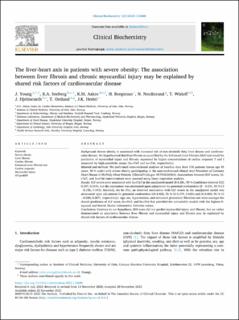| dc.description.abstract | Background: Severe obesity is associated with increased risk of non-alcoholic fatty liver disease and cardiovascular disease. We hypothesized that liver fibrosis as quantified by the Enhanced Liver Fibrosis (ELF) test would be predictive of myocardial injury and fibrosis, expressed by high sensitivity cardiac troponin T and I (hs-cTnT and hs-cTnI) concentrations. Material and methods: We performed cross-sectional analyses of baseline data from 136 patients (mean age 45 years, 38 % male) with severe obesity participating in the non-randomized clinical trial Prevention of Coronary Heart Disease in Morbidly Obese Patients (ClinicalTrials.gov NCT00626964). Associations between ELF scores, hs-cTnT, and hs-cTnI concentrations were assessed using linear regression analysis. Results: ELF scores were associated with hs-cTnT in the unadjusted model (B 0.381, 95% Confidence Interval [CI] 0.247, 0.514), but the association was attenuated upon adjustment for potential confounders (B -0.031, 95% CI -0.155, 0.093). Similarly, for hs-cTnI, an observed association with ELF scores in the unadjusted model was attenuated upon adjustment for potential confounders ((B 0.432, 95% CI 0.179, 0.685) and (B 0.069, 95% CI -0.230, 0.367), respectively). Age, sex, hypertension, and estimated glomerular filtration rate were amongst the shared predictors of ELF score, hs-cTnT, and hs-cTnI that provided the univariable models with the highest R-squared and lowest Akaike Information Criterion values. Conclusions: Contrary to our hypothesis, ELF score did not predict myocardial injury and fibrosis, but rather demonstrated that an association between liver fibrosis and myocardial injury and fibrosis may be explained by shared risk factors of cardiovascular disease. Keywords: Enhanced Liver Fibrosis test; NT-proBNP; cardiac fibrosis; cardiac troponin; liver fibrosis; myocardial injury; severe obesity. | en_US |

